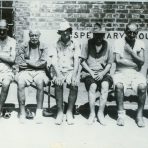Bascombe’s ‘A History of Epidemic Pestilences from the earliest ages 1495 years before the birth of our Saviour to 1848’, is a historical account of diseases around the world. Since there was no concept of germ theory, no one understood the cause of these outbreaks or how they spread and so they were often attributed to supernatural causes. In his book these occurrences of ‘pestilence’ often coincide with comets. In AD 1401 “A comet was seen. Pestilence broke out at Florence. 30,000 persons died of epidemic disease this year in London”. (p. 38) The year 1819 “was marked by great commotions of the elements, and a general spread of epidemic pestilence all over the world. “(p.153)
The symptoms ascribed to these ‘pestilences’ are sometimes quite extraordinary and seem to suggest a kind of mass hysteria.
In AD 1374 “the epidemic dancing disease of St. Guy and St. John prevailed in Holland and in the Renish provinces …The disease also prevailed in France and the sufferers were called ‘Convulsionnaires;’…Hecker gives the following account of this strange malady..it was a convulsion which, in the most extraordinary manner, infuriated the human frame, and excited the astonishment of contemporaries for more than two centuries..It was called the Dance of St John or of St Victus, on account of the Bacchantic leaps by which it is characterized, and which gave to those affected , whilst performing their wild dance, and screaming and foaming with fury, all the appearance of persons possessed…(p.56) They formed circles hand-in-hand and, appearing to have lost all control over their senses, continued dancing, regardless of the bystanders for hours together, in wild delirium, until at length they fell down to the ground in a state of exhaustion.” (p.57)
In AD418 “Strasburgh was visited by the ‘Dancing Plague’ and the same infatuation existed amongst the people there as in the towns of Belgium and the Lower Rhine AD 1374; many who were seized on seeing the affected, excited attention at first by their confused and absurd behaviour, and then by their constantly following the swarms of dancers. These were seen day and night passing through the streets , accompanied by musicians playing on bagpipes, and by innumerable spectators attracted by curiosity, “(p. 63)
There were numerous plagues alongside more mysterious illnesses such as the ‘sweating sickness’, which made its appearance in England in A.D.1517. “So rapid and violent was this disease in its course, that it carried off those who were attacked in two of three hours, so that the first shivering fit was the announcement of death; many who were in good health at noon-day were corpses by evening.” (p. 77)
Library users are welcome to consult any of these books on Library premises. To reserve a book, just go to the catalogue entry on Discover while you are logged into your LSHTM account and follow the instructions underneath the heading “Get It.” You’ll receive an email when it’s available. However, please note that these books will need to be read within the Library and cannot be borrowed like other resources.




